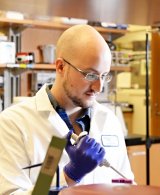Thesis defense for Nicholas A. Kovacs:Data Mining the Structure of the Ribosome to Unravel the History of Proteins Committee members: Prof. Loren Williams - School of Chemistry and Biochemistry (Advisor) Prof. Nicholas Hud - School of Chemistry and Biochemistry Prof. M.G. Finn - School of Chemistry and Biochemistry Prof. King Jordan - School of Biological Sciences Prof. Jeffrey Skolnick - School of Biological Sciences Abstract: Contained within every cell of every organism on Earth is a molecular fossil that has recorded the evolution of life since its origin approximately 4 billion years ago. Composed of both RNA and protein, the ribosome is the molecular tape-recorder that has logged the evolution of life within the sequences and structures of its RNA and protein. The structure of ribosomal RNA contains its evolution. We extend the model of ribosomal evolution to include ribosomal protein. The evolution of protein was guided by the ribosome, on the ribosome, and for the ribosome. Ribosomal proteins that are present in all of life today present a molecular chronology of the origins and evolution of protein. We show that partitions of ribosomal proteins reveal the history of protein folding which stretches back since the origin of life. The data support a model in which (i) short, random coil polypeptides accreted onto the surface of the ribosome, and (ii) lengthened over time and coalesced into β-structures. (iii) These β-structures then collapsed, primarily into β-domains. (iv) Domains accumulated and gained complex super-secondary structures composed of both α-helix and β-strands. Life then diversified into its 3 domains and ribosomal proteins accrued elaborations on their structures. (v) In archaea and eukarya, insertions in ribosomal proteins gave rise to internal loop protrusions from their globular domains composed of unstructured segments as well as α-helices which buried into ribosomal RNA structure and made contacts with other ribosomal proteins. (vi) In eukarya, α-helical extensions on the termini of ribosomal proteins gave rise to intricate ribosomal protein-ribosomal protein interactions on the surface of the ribosome.

Nicholas Kovacs, PhD Bioinformatics